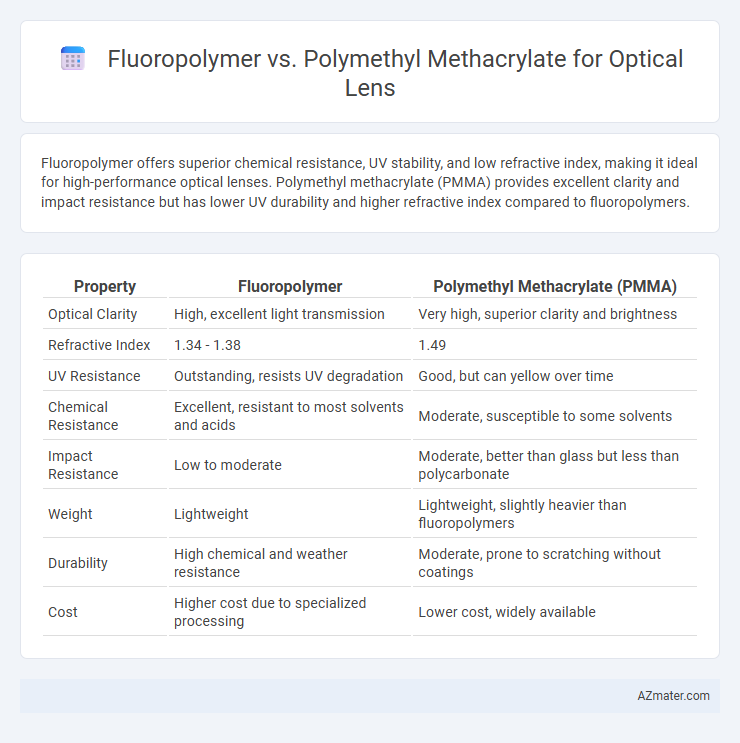Fluoropolymer offers superior chemical resistance, UV stability, and low refractive index, making it ideal for high-performance optical lenses. Polymethyl methacrylate (PMMA) provides excellent clarity and impact resistance but has lower UV durability and higher refractive index compared to fluoropolymers.
Table of Comparison
| Property | Fluoropolymer | Polymethyl Methacrylate (PMMA) |
|---|---|---|
| Optical Clarity | High, excellent light transmission | Very high, superior clarity and brightness |
| Refractive Index | 1.34 - 1.38 | 1.49 |
| UV Resistance | Outstanding, resists UV degradation | Good, but can yellow over time |
| Chemical Resistance | Excellent, resistant to most solvents and acids | Moderate, susceptible to some solvents |
| Impact Resistance | Low to moderate | Moderate, better than glass but less than polycarbonate |
| Weight | Lightweight | Lightweight, slightly heavier than fluoropolymers |
| Durability | High chemical and weather resistance | Moderate, prone to scratching without coatings |
| Cost | Higher cost due to specialized processing | Lower cost, widely available |
Introduction to Optical Lens Materials
Fluoropolymer optical lenses offer exceptional chemical resistance, low refractive index, and high transparency, making them ideal for advanced optical applications requiring durability and minimal light distortion. Polymethyl methacrylate (PMMA) lenses provide excellent clarity, lightweight properties, and cost-effectiveness, commonly used in everyday optical devices and lenses. The choice between fluoropolymers and PMMA depends on specific optical performance requirements such as UV resistance, impact strength, and environmental stability.
Overview of Fluoropolymers
Fluoropolymers exhibit exceptional chemical resistance, low surface energy, and high transparency, making them ideal for advanced optical lens applications requiring durability and clarity. Their intrinsic hydrophobic and anti-reflective properties reduce glare and enhance light transmission compared to conventional polymers. Unlike polymethyl methacrylate (PMMA), fluoropolymers offer superior UV resistance and thermal stability, extending lens lifespan in demanding environments.
Polymethyl Methacrylate (PMMA): Key Properties
Polymethyl Methacrylate (PMMA) offers excellent optical clarity with a light transmittance of approximately 92%, making it highly suitable for optical lenses requiring sharp, distortion-free vision. PMMA exhibits superior UV resistance and good scratch resistance, enhancing durability while maintaining low density for lightweight applications. Compared to fluoropolymers, PMMA provides better rigidity and hardness, though fluoropolymers outperform in chemical resistance and flexibility, positioning PMMA as an optimal choice for robust, clear, and economical optical lens manufacturing.
Optical Clarity: Fluoropolymer vs PMMA
Fluoropolymers offer superior optical clarity compared to polymethyl methacrylate (PMMA) due to their low refractive index and excellent light transmission, making them ideal for high-performance optical lenses. PMMA provides good transparency with a refractive index of about 1.49 but can exhibit more surface haze and lower durability under UV exposure. The enhanced clarity and UV resistance of fluoropolymers result in lenses with reduced light scattering and better long-term optical performance.
Chemical Resistance Comparison
Fluoropolymers exhibit superior chemical resistance compared to polymethyl methacrylate (PMMA), making them highly resistant to solvents, acids, and bases commonly encountered in optical lens applications. PMMA tends to degrade or swell when exposed to harsh chemicals, whereas fluoropolymers maintain structural integrity and optical clarity under aggressive chemical conditions. This enhanced chemical resistance extends the lifespan and performance reliability of optical lenses used in demanding environments.
Mechanical Strength and Durability
Fluoropolymers exhibit superior mechanical strength and chemical resistance compared to polymethyl methacrylate (PMMA), making them more durable for optical lens applications exposed to harsh environments. PMMA offers excellent optical clarity but tends to be more prone to scratching and impact damage, limiting its long-term durability. Fluoropolymer lenses maintain structural integrity under stress and resist UV degradation, enhancing their lifespan in demanding optical uses.
UV Resistance and Weatherability
Fluoropolymer lenses exhibit superior UV resistance and weatherability compared to polymethyl methacrylate (PMMA), maintaining optical clarity and structural integrity under prolonged exposure to ultraviolet radiation and harsh environmental conditions. The molecular structure of fluoropolymers provides excellent chemical inertness and low surface energy, reducing degradation and yellowing often seen in PMMA lenses. Consequently, fluoropolymer materials are preferred for outdoor optical applications requiring long-term durability and consistent performance in UV-intensive environments.
Manufacturing and Machinability
Fluoropolymers offer superior chemical resistance and low refractive index, making them advantageous for specialized optical lenses but pose challenges in manufacturing due to their high melting points and low surface energy, which require precise temperature control and specialized machining techniques. Polymethyl methacrylate (PMMA) provides excellent machinability with its lower melting temperature and ease of shaping through CNC machining and injection molding, resulting in cost-effective production and smooth surface finishes ideal for mass optical lens fabrication. Manufacturing choices favor PMMA for high-volume, precision lenses, while fluoropolymers are selected for niche applications demanding enhanced durability and performance under harsh environmental conditions.
Cost Efficiency and Availability
Fluoropolymer lenses offer superior chemical resistance and lower refractive indices but tend to have higher manufacturing costs and limited availability compared to polymethyl methacrylate (PMMA) lenses. PMMA lenses provide a cost-efficient solution with widespread availability, making them a popular choice in consumer optics despite lower durability and chemical resistance. The balance of cost efficiency and material properties often leads to PMMA being favored in large-scale production, while fluoropolymers are reserved for specialized applications requiring enhanced performance.
Ideal Applications: Selecting the Optimal Lens Material
Fluoropolymer lenses excel in high-performance optical applications requiring exceptional chemical resistance, UV stability, and low refractive index, making them ideal for medical devices, aerospace, and harsh outdoor environments. Polymethyl methacrylate (PMMA) offers superior optical clarity, lightweight characteristics, and cost-effectiveness, suited for consumer optics, eyewear, and lighting covers. Choosing the optimal lens material depends on balancing factors such as environmental durability, optical precision, and budget constraints to meet specific application requirements.

Infographic: Fluoropolymer vs Polymethyl methacrylate for Optical Lens
 azmater.com
azmater.com